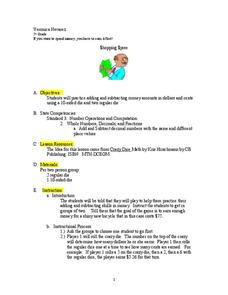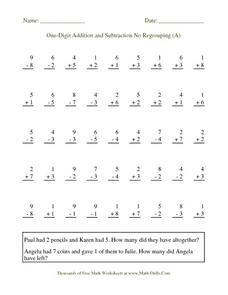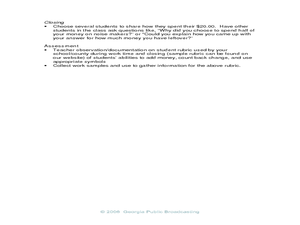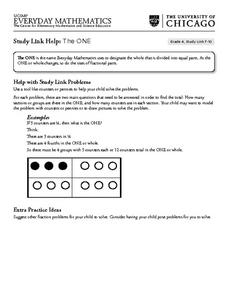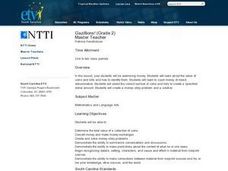Curated OER
Basic Equivalencies
First graders manipulate plastic coins to show equivalencies between pennies and dimes and to show specific values using them. They practice independently to stamp different values a variety of ways.
Curated OER
Pennies and Nickels and Dimes...Oh, My!
Students play a game in which they determine the number of cents that equal a nickel, dime, and quarter. They identify which set of coins has more, fewer, or the same amount while also counting each collection and writing the...
Curated OER
Math Lesson Study Plan
Second graders find missing addends by solving math word problems. In this missing addend lesson, 2nd graders work in a whole group setting to find the missing addends in word problems before using the strategies to work independently....
Curated OER
Shopping Spree
Sixth graders examine currency by completing monetary equations. In this economics lesson, 6th graders participate in a numbers experiment where they roll a die and earn money based on their roll. Students compete for their fictitious...
Curated OER
Mixing Coins
Young scholars explore mixed (different denomination) coin sets and create different total amounts.
Curated OER
Math/Technology: Coin Combos
Second graders identify coin combinations needed to purchase items under a dollar. Using Kidspiration, they demonstrate three ways to purchase a pizza slice for 96 cents and choose an item which cost less than a dollar for other to...
Curated OER
Quarters, Dimes, Nickels, and Pennies
In this money worksheet, 3rd graders will examine the photos of coins and write the correct amount. Students will complete ten problems counting quarters, dimes, nickels, and pennies to conclude how much is in each picture.
Curated OER
Million Dollar Project
Each student is given the task of spending $1 million. The way students spend their money is dependent on a theme such as "creating a dream world," "taking a trip," or "doing something to better society." Each student researches,...
Virginia Department of Education
Probability
Classes explore different scenarios using manipulatives to learn about the difference between independent and dependent probability. Learners experiment with colored chips to model the two types of probabilities. To test their...
Virginia Department of Education
Greetings
Welcome learners to the world of algebra. Use a instructional activity that poses a situation involving the profit from creating greeting cards to teach about algebra. It requires scholars to use linear functions and inequalities to...
Curated OER
One-Digit Addition and Subtraction No Regrouping (A)
In this math worksheet, students solve 81 problems in which one-digit numbers are added and subtracted. Problems are in a vertical format with addition and subtraction mixed in each row.
Curated OER
Planning and Shopping for the Menu
Students plan a menu considering the number of people to be served and the amount of money they have to work with to buy the necessary ingredients.
EngageNY
More Examples of Functions
Discrete or not discrete? Individuals learn about the difference between discrete and non-discrete functions in the fourth installment of a 12-part module. They classify some examples of functions as being either discrete or non-discrete.
Curated OER
Model and Solve Algebraic Equations
Examine multiple ways to solve algebraic equations. Pupils will generate a problem solving strategy that addresses the prompt given by the teacher. They will then share their problem solving strategy with the class. Graphic organizers,...
Curated OER
Making Change
Students investigate how to make change when purchasing items. In this making change lesson, students examine a scenario to calculate the correct change. Students play Bingo based on information and calculations to determine the amount...
Curated OER
Shopping for a Party
Second graders produce a budget for a party. In this money management lesson, 2nd graders create a budget for an imaginary party they will have based on a $20.00 limit. Students observe a video clip in class discussing budgets.
Curated OER
Let's Try Various Calculations
Young scholars explore math facts. In this calculation and math facts lesson, students play a board game in which addition, subtraction, multiplication, and division math facts are practiced. A copy of the game is included.
Curated OER
Decimals for Lower Elementary
Students investigate decimal operations, including addition and subtraction. They participate in interactive games, story problems, and math mysteries.
Curated OER
The One
For this problem solving worksheet, 4th graders utilize counters or pennies to learn about the parts of a whole in 4 groups of 3 circles that equal 12 counters.
Curated OER
You're the Cashier!
Third graders use manipulatives and computers to count back change from amounts up to $5.00.
Curated OER
Gazillions!
Second graders determine the total value of a collection of coins. They convert money and make money exchanges. Students create and solve money-story problems. They demonstrate the ability to summarize conversations and discussions.
Illustrative Mathematics
Price per Pound and Pounds per Dollar
Help learners understand the concept of unit rate as it is applied to buying beans at a grocery store. The objective is to determine the unit rate in two ways, and then apply each ratio to an additional problem. The attached commentary...
Curated OER
Tiling Tessellations
Young scholars explore tessellations. In this shapes and geometry lesson, students describe the attributes of many of the shapes displayed on an Elmo. Young scholars create examples of tessellations using pattern blocks.
Money Math for Teens
Debt Elimination - Power Tools for Building Wealth
What does it mean to be wealthy? Your learners will consider how carrying debt affects budgeting, and learn about the debt snowball strategy and how is it used in the concept of eliminating debt in order to build wealth.





